Trondheim Stavne Cemetery
| Other Memorials |
| I have photographed quite a few of the graves at Stavne, if you require a photograph of one in paricular please contact me providing relevant information and I will see if I have it. archieraf@yahoo.co.uk |
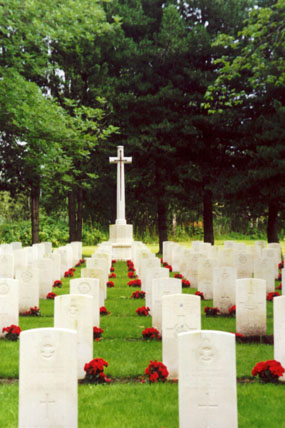 |
The town of Trondheim is situated on the West Coast of Norway approximately 190 miles north of Oslo. This cemetery contains the largest Commonwealth War Graves Plot in Norway, and it is here that Archie, and two other members of his crew, Sergeant A M McLaren and Sergeant D Francis are buried. Four members of his crew were never recovered, Sergeant L J Nelmes, Flight Sergeant G H G Murray, Sergeant J F Staff and Sergeant S Palmer, their names are commemorated on the Runnymede Memorial which overlooks the River Thames at Cooper's Hill, Englefield Green, between Windsor and Egham, Surrey, England. Many of the airmen who lost their lives over Norway during attacks on the German Battleship Tirpitz between 1942 and 1944 have graves here too. There are a total of 155 Commonwealth War Graves of allied servicemen from WW2 at this cemetery. 27 Navy, 24 Army, 99 Air Force, 5 Merchant Navy, of which 140 are British, 6 Canadian, 5 Australian, 3 New Zealand and 1 South African. |
|
Trondheim Stavne Cemetery.
Photo: L Defty |
| Below are the graves of the three crew members, whose bodies were recovered, from Halifax R9496 TL-L from 35 Squadron which was shot down on the night of March 30/31 1942 during a raid against the German Battleship Tirpitz |
|
Flt Sergeant William Bruce Archibald
Photo: L Defty |
Sergeant Douglas Francis.
Photo: L Defty |
Sergeant Archibald McLaren
Photo: L Defty |
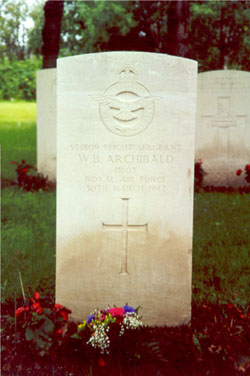 |
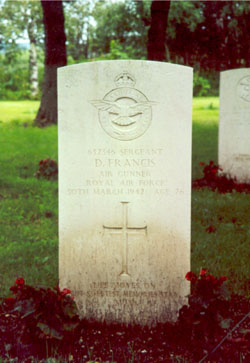 |
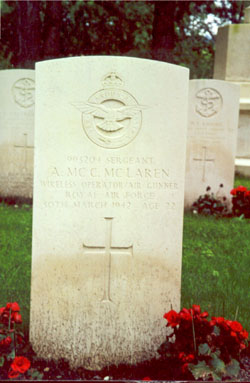 |
|
At dusk on the 60th anniversary of the 30/31 March 1942 raids against Tirpitz, candles were lit on the graves of the men who lost their lives during this attack and who's bodies were recovered and interred at Stavne Cemetery on April 8th 1942. These were the graves of Flight Sergeant William Bruce Archibald, Sergeant Douglas Francis and Archibald McCulloch McLaren from R9496 TL-L of 35 Squadron. Flight Sergeant George Steinhauer from W1015 TL-P of 35 Squadron, and Squadron Leader Frederick David Webster DFC from W1043 ZA-F of 10 Squadron. My most sincere thanks are due to Morten Moe for his thoughtfulness and for providing the photograph. |
|
60th Anniversary 31st March 2002
|
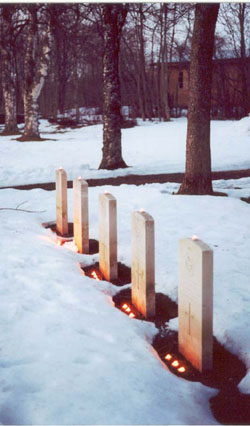 |
|
A plaque mounted on a granite plinth within the Commonwealth War Graves Commission plot gives the following outline about the war in Norway: The War in Norway 1940-1945 On 9th April 1940, Hitler's Germany, already at war with the Commonwealth, France and Poland (the Allies), invaded Norway and by that evening had captured Oslo, the ports of Kristiansand, Bergen, Trondheim and Narvik and Sata, the airfield at Stavanger. The German objectives were to secure naval and airbases on the west coast and the use of the ice free route along that coast for the shipping of iron ore from the Gattivare mines. The invasion disrupted the Norwegian Army's mobilisation, but the Norwegian Navy and the coast defences inflicted serious losses on German warships and transport, which were also attacked in the Skagerrak by British submarines. On 10th April a flotilla of five British destroyers sank two German destroyers and six supply ships in Narvik harbour. Two British ships were lost. On the 13th the Battleship HMS Warspite and seven destroyers with air cover from the carrier HMS Glorious sank the remaining German ships. Although Southern Norway was lost, there seemed a chance of holding Central Norway if the Gudbrandsdal and Osterdal could be held and the German garrison in Trondheim overcome. Norwegian troops were stoutly defending the routes through these valleys and Allied forces were landed, 'Moriceforce', at Namsos on the 14th and 'Sickleforce' at Andalsnes on the 17th, to capture Trondheim by a pincer movement. Mauriceforce, comprising the British 146th Brigade and three battalions of French Chasseurs Alpins, advanced southwards but were held at the head of Trondheim Fjord by a German column which had come out to meet it and had shelled from the fjord by warships which also landed troops to threaten it's flank. Sickleforce, comprising the British 15th and 148th Brigades, advanced to Dombas which was held by Norwegian forces after a German parachute attack had been repelled, then southwards in reinforcement of the Norwegian defenders who were under pressure in the Gudbrandsdal. Although the German advance was checked twice at Kvam and Otta, the positions could not be held under threat to the lines of communication to Andalsnes from a parallel German advance up the Osterdal. Only very limited air support could be given from carriers and from a squadron of fighters, which operated from the frozen Lesjaskog Lake near Dombas. When the depleted squadron was forced to withdraw, the consequent German aerial dominance exposed the troops to constant harassment while the Namsos and Andalsnes bases were made nearly useless by bombing. Both Mauriceforce and Sickleforce were now being driven back and on 27th April the decision was taken to withdraw from Central Norway. The evacuation was completed by 3rd May. On 16th April a force, codename 'Ruperforce', comprising the 24th (Guards) Brigade, three battalions of Chasseurs Alpins and two of the Foreign Legion and a Polish Brigade, began to land at Harstad, selected as the base for the assault on Narvik. Several Norwegian units, comprising both infantry and mountain artillery participated. Harstad was at first frequently raided by German aircraft, but on 21st May the airfield at Bardufoss was brought in to full operation and a squadron of Gladiator fighters and one of Hurricanes based there. This gave the Royal Air Force a local ascendancy, which greatly assisted the conduct of the land operation. The Guards Brigade, reinforced by five 'independent guerrilla companies' was deployed to defend the ports of Mosjoen, Mo and Bodo against German landings. Mosjoen was held until the 10th, Mo until the 18th and Bodo until 31st May. The remainder of Rupertforce, in which the British component was and anti-aircraft brigade, meanwhile attacked Narvik and recaptured it on 27th May. Allied reserves in France then compelled withdrawal of the force, which was completed on 8th June. The troop convoys, one of which carried the King of Norway and his Government, reached Britain unscathed but HMS Glorious and her escorting destroyers Acasta and Ardent were sunk by the battle-cruisers Scharnhorst and Gneisenau with heavy loss of life. Supported by supplies dropped by the Royal Air Force, by bombing raids and by British/Norwegian Commandos, raids along the coast, the Norwegian Resistance movement effectively prevented any reduction in the German garrison for the remainder of the war, at the cost of many lives. On 8th May 1945, Norwegian and British troops landed in Norway, followed on 13th May by Crown Prince Olav and representatives of the Norwegian Government. With the return of King Haakon on 7th June 1945 exactly 5 years to the day after he left the country - the liberation of Norway was a fact. |
© Linzee Druce 2001-2012